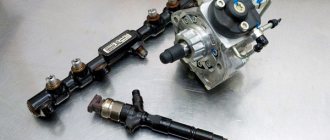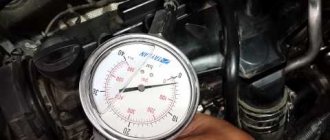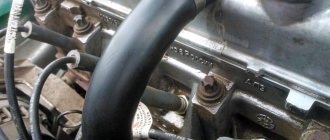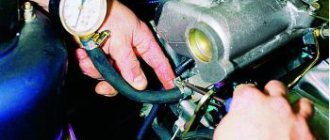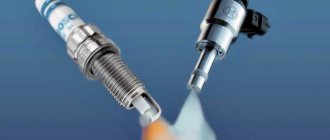Engines Kia Sorento 4 (MQ4)
The presentation of the fourth generation Kia Sorento (production number MQ4) was scheduled for March 2021. Venue: Switzerland, Geneva. But due to the COVID-19 pandemic, the auto show was canceled. The Koreans held a presentation of the Kia Sorento 4 online on March 18.
The Kia Sorento IV is a classic example of an urban crossover, which is suitable for active recreation enthusiasts with an above-average income.
Provided you travel on roads of proper quality. You can choose from front-wheel drive or all-wheel drive versions. Kia Sorento IV is equipped with the following power plants:
- D4HE – 2.2 diesel, 199 horsepower combined with a robotic transmission and all-wheel drive;
- G4KM – gasoline 2.5, 180 hp. Available with automatic transmission and front- or all-wheel drive.
Petrol 2.5 G4KM
The production of the Hyundai G4KM SmartStream 2.5 MPI gasoline internal combustion engine of the Theta III family began in 2021. They are equipped with the Kia Sorento 4 and Hyundai Sonata 8.
The Kia Sorento IV power unit uses a distributor fuel injection system.
Technical characteristics of the 2.5 G4KM gasoline engine:
- volume (cubic cm) – 2497;
- power (hp) – 180;
- torque: M (N*m) – 232;
- power supply system – distribution injection;
- cylinder block – aluminum R4;
- cylinder head: cylinder head – aluminum;
- compression ratio – 10.5;
- cylinder diameter (mm) – 88.5;
- piston stroke (mm) – 101.5;
- design differences between internal combustion engines - DOHC;
- Timing drive – chain;
- hydraulic compensators – yes;
- phase regulator - at the inlet and outlet;
- turbocharging – absent;
- fuel – AI-95 gasoline;
- motor lubricant volume (l) – 5.9;
- engine oil – 5W-30;
- environmental class – EURO 5;
resource (thousand km.) – about 250.
It has not yet been possible to identify all the problems with the internal combustion engine of the G4KM Kia Sorento IV.
This is due to the recent release of the engine. However, the 4th generation Kia Sorento internal combustion engine already has the following engine drawbacks:
- increased oil consumption;
- hydraulic compensators are sensitive to oil quality;
- the proximity of the catalyst to the block, which is dangerous due to its particles entering the combustion chamber;
New diesel 2.2 D4HE
There is not a lot of information about the new 2.2 diesel Hyundai/Kia yet.
The following are the operating parameters of the engine:
- volume – 2151;
- power – 199;
- torque – 440;
- type of power unit - in-line design with four cylinders;
- number of valves per cylinder – 4;
- compression ratio – 16;
- supercharger - turbine;
- fuel - diesel.
Specifications
Kia Sorento 2.4 is a Korean crossover-type car. The vehicle is equipped with a power unit marked G4KE / 4B12. This is a standard 4B powertrain manufactured by Mitsubishi, but upgraded by Hyundai Motor for use in their vehicles.
Among the updates and modernizations it is worth highlighting:
- Enlarged crankshaft and piston stroke up to 97 mm.
- Piston diameter 88 mm.
- The absence of hydraulic compensators, which does not require frequent adjustment of the valve mechanism.
| Name | Index |
| Manufacturer | Hyundai Motor Manufacturing Alabama/Mitsubishi Motors Corporation |
| 2.4 liter (2359 cm3) | |
| Number of cylinders | |
| Number of valves | |
| Cylinder diameter | |
| Injection system | Injector |
| Power | |
| Fuel consumption | |
| Econorm | |
| Oil used | |
| How much oil is in the engine | |
| 250+ thousand km | |
| Applicability to other vehicles | Kia Cerato Kia Optima Kia Sportage Kia Sorento Hyundai ix35 Hyundai Sonata Hyundai Santa Fe Mitsubishi Lancer Mitsubishi Outlander Mitsubishi Delica Chrysler 200 Chrysler Sebring Citroën C-Crosser Dodge Avenger Dodge Caliber Dodge Journey Jeep Compass Jeep Patriot Peugeot 4007 Jeep Patriot Proton Inspira |
Change of oil
Motor oil is an integral part of every car's heart. This fluid provides lubrication to engine parts and also removes 15% of the heat generated by the engine. But, like any other liquid, motor oil tends to lose its beneficial qualities, therefore, according to the manufacturer’s recommendations, it is changed every 15,000 km.
Let's look at the basic principles of changing engine oil with your own hands in a Kia Sorento 2.4.
- We place the vehicle on an overpass (pit or lift) and let it cool.
- We dismantle the lower motor protection.
- Unscrew the drain bolt on the crankcase block. You must first install a container under the drainage area.
- After the liquid is almost drained, unscrew the oil filter and install a new element.
- We tighten the filler plug.
- Unscrew the engine filler neck and fill in new engine oil.
After running in 2-3 km, it is necessary to add lubricant to the engine.
Malfunctions and repairs
At its core, the Kia Sorento 2.4 174 hp power unit. marked G4KE / 4B12 has no significant disadvantages. But, despite all the advantages, it has malfunctions that arise quite often.
Sorento engine.
- The engine starts running like a diesel engine. Contamination of injectors and structural features of the power unit. Particular attention should be paid to contamination of the piston, as well as the formation of the air-fuel mixture.
- Whistle in the engine compartment. These are all signs of a faulty air conditioner bearing. Replacing the element will help fix the problem.
- Chirping. Many car enthusiasts are starting to get nervous, but don’t. This is the normal state of the injectors.
- Vibration at low speeds. This is a sign of faulty spark plugs. In this case, it is worth replacing the elements.
- A quiet hissing sound. Don’t think that there is a snake in the car - this is the usual operation of the gasoline pump.
Engines Kia Sorento Prime (3rd generation 2014-2020)
In the summer of 2014, the presentation of the 3rd generation Kia Sorento (serial number UM) took place in South Korea. The world premiere took place two months later in Paris. Korean, German and American designers worked together to develop the model.
A mid-size SUV with updated exterior and interior design, modified optics, new engines and increased dimensions compared to the 2nd generation Kia Sorento.
on the domestic market in the second half of 2015. Due to the continued sales of second-generation cars, the third was named Kia Sorento Prime. The production of cars was established at the Avtotor enterprise in Kaliningrad.
The third generation of the Korean crossover is equipped with the following modifications of the internal combustion engine:
- D4HB – Kia Sorento 2.2 diesel engine with 200 horsepower;
- G4KE – gasoline 2.4, 188 hp;
- G6DB is a 3.3-liter gasoline power unit with a power of 250 hp.
After restyling in 2021, the 3.3 G6DB power plant was also replaced by a V6, but 3.5 G6DC.
All third-generation Kia Sorento internal combustion engines are equipped with an automatic transmission with all-wheel drive.
Diesel 2.2 D4HB
The diesel engine Kia Sorento 2.2 Hyundai D4HB was presented in 2009.
The engine is produced at production facilities in Korea. The series of aluminum internal combustion engines received the short name R. It also includes a modification of the D4HA power unit.
Technical characteristics of the 2.2 D4HB diesel engine:
- volume – 2199;
- power – 197-200;
- moment (M) – 421-441;
- engine type - in-line with four cylinders;
- number of valves – 16;
- power system – Common Rail;
- compression ratio – 16;
- cylinder diameter – 85.4;
- piston stroke – 96;
- fuel – diesel;
- environmental class – EURO 4/5/6;
resource - according to factory data 250, but in practice it is more.
Depending on the driving mode, fuel consumption per hundred kilometers is:
- 5.4 l – outside the city;
- 8.7 – within a populated area;
- 6.6 – mixed cycle.
The advantages of the motor include:
- efficiency and environmental friendliness;
- decent level of reliability;
- good dynamic performance;
- use of the latest design solutions.
Negative points include:
- requires specialized services;
- injector sensitivity to fuel quality;
- noisy operation of the gas distribution mechanism;
- complex process of changing spark plugs.
During operation of the 2.2 D4HB power unit, the following problems are observed:
- With an aggressive driving style, there is an increased oil consumption - up to half a liter per hundred kilometers.
- Knocks and noises from the gas distribution mechanism - due to poor lubrication, the hydraulic tensioner channel becomes clogged over time.
- Periodically, the engine stalls or stalls due to the whimsical piezoelectric injectors.
- Reduced traction - due to a clogged diesel coarse filter element.
Petrol 2.4 G4KE
Technical characteristics of the Kia Sorento 2.4 G4KE petrol engine:
- volume – 2359;
- power – 172-180;
- M – 225-231;
- power supply system – injection;
- engine type - in-line with four cylinders;
- number of valves per cylinder – 4;
- cylinder block - aluminum;
- compression ratio – 10.5;
- cylinder diameter – 88;
- piston stroke – 97;
- fuel – AI-95 gasoline;
- volume of lubricant in the engine – 4.6;
- engine oil – 5W-40;
- environmental class – EURO 4/5;
resource – more than 200.
Fuel consumption in liters per 100 km:
- 12.9 – in the urban cycle;
- 7.5 – on the highway;
- 9.4 is the average when combining driving modes.
Characteristic disadvantages of the Kia Sorento 2.4 G4KE engine include:
- excessive noise and vibration
- periodic clogging of the throttle assembly, which is accompanied by interruptions in idle speed
- failure of the phase regulator, air conditioning compressor bearing and oil pump. The latter case leads to rotation of the connecting rod bearings
- destruction of the intake manifold with significant mileage.
V6 3.3 G6DB
The Kia Sorento 3.3 Hyundai G6DB engine was produced in South Korea from 2006 to 2010. It was intended for mid-size SUVs and sedans.
The internal combustion engine belongs to the first Lambda series, which is equipped with a phase regulator only at the inlet.
Kia Sorento V6 3.3 G6DB engine characteristics:
- volume – 3342;
- power – 235-245;
- M – 300-310;
- power supply system – injection;
- cylinder block – aluminum V6;
- Cylinder head – aluminum 24v;
- compression ratio – 10.4;
- cylinder diameter – 92;
- piston stroke – 83.8;
- there are no design differences in the power unit;
- timing drive – chain;
- hydraulic compensators – no;
- phase regulator - at the inlet;
- turbocharging – absent;
- fuel – AI-95 gasoline;
- volume of motor lubrication – 5.2;
- engine oil – 5W-30;
- environmental class – EURO 3/4;
resource - about 300.
Fuel consumption per hundred kilometers is:
- 14.4 l – in the urban cycle;
- 8.3 – on the highway;
- 10.5 – in mixed mode.
The motor has the following disadvantages:
- increased oil consumption
- occurrence of piston rings
- If the level of lubricant in the internal combustion engine is insufficient, there is a high probability of turning the crankshaft liners
- instability of idle speed - in most cases due to clogged throttle valve
V6 3.5 G6DC
Production of the Hyundai V6 3.5 G6DC Lambda II series internal combustion engine has been carried out in South Korea since 2009. The power unit is equipped with phase regulators on both shafts.
To reduce transport tax, in Russia the engine power is reduced to 249 horsepower.
Kia Sorento V6 3.5 G6DC engine characteristics:
- volume – 3470;
- power – 275-290;
- M – 330-340;
- power supply system – injector;
- cylinder block – aluminum V6;
- Cylinder head – aluminum 24v;
- compression ratio – 10.6;
- cylinder diameter – 92;
- piston stroke – 87;
- There are no design differences between the internal combustion engine;
- timing drive – chain;
- hydraulic compensators – no;
- phase regulator - at the inlet;
- turbocharging – absent;
- fuel – AI-95 gasoline;
- volume of motor lubrication – 6.5;
- engine oil – 5W-20;
- environmental class – EURO 4/5;
- resource - about 300.
Fuel consumption for a Kia Sorento with a V6 3.5 G6DC engine in liters per 100 km is:
- 14.5 – within a populated area;
- 8.1 – on the highway;
- 10.4 – in mixed mode.
The power plant problems are similar to the modification of the V6 3.3 G6DB engine.
Generation II Sorento engines
A fairly updated Sorento was introduced in 2009. Now the car has become more roadworthy, having replaced the frame with a monocoque body. Increasing its rigidity and using high-quality metal made it possible to achieve a maximum of 5 stars in the EuroNCAP safety rating. Sorento for Russia is assembled at a plant in Kaliningrad. The crossover is popular, and therefore its production continues to this day.
The result of a program to unite automakers to create a common engine was the G4KE unit. It is a complete copy of the Japanese 4B12 from Mitsubishi. The French install the same engine on the Citroen C-crosser and Peugeot 4007 crossovers.
The G4KE engine belongs to the Theta II series and is a version of the G4KD with a volume increased to 2.4 liters. To do this, the designers installed a different crankshaft, thanks to which the piston stroke increased from 86 to 97 mm. The cylinder diameter has also grown: 88 mm versus 86. The block and cylinder head are aluminum. The engine is equipped with two camshafts with CVVT phase shifters on each. Hydraulic compensators are not provided; the valves require manual adjustment. The timing chain is maintenance-free and designed for the entire service life of the engine.
The main problems of the unit are exactly the same as those of the two-liter G4KD. During a cold start, the engine is very noisy. Sounds like an old diesel. When the motor reaches operating temperature, it disappears.
In the range of 1000-1200 rpm, strong vibrations occur. The problem is the candles. A chattering noise is another common complaint. It is created by fuel injectors. It's just a feature of their work.
| Engine | G4KE |
| Type | Gasoline, naturally aspirated |
| Volume | 2359 cm³ |
| Cylinder diameter | 88 mm |
| Piston stroke | 97 mm |
| Compression ratio | 10.5 |
| Torque | 226 Nm at 3750 rpm. |
| Power | 175 hp |
| Overclocking | 11.1 s |
| Maximum speed | 190 km/h |
| Average consumption | 8.7 l |
A new series of Hyundai R diesel units was introduced in 2009. It includes two engines: 2 and 2.2 liters. The latter is installed on the Kia Sorento. This is a four-cylinder in-line engine with a cast iron block and an aluminum cylinder head. There are 4 valves per cylinder. The third generation Bosch fuel system with piezoelectric injectors operates at a pressure of 1800 bar. Supercharging is carried out by an e-VGT turbine with variable geometry.
To reduce vibrations, the designers introduced a balancer shaft. Hydraulic compensators automatically adjust valve clearances. Diesel meets Euro-5 standards. To achieve this, a particulate filter and highly efficient EGR are installed in the exhaust system.
The manufacturer claims that the resource of the unit is 250,000 km. Like any other engine, the D4HB has weak points. During dynamic driving, the engine tends to consume oil up to 500 ml per 1000 km. Modern fuel equipment is very demanding on fuel quality. Repairs are carried out only in specialized services and the prices for spare parts are quite high. Therefore, it is advisable to refuel only at proven gas stations. Due to low-quality oil or infrequent changes, the hydraulic tensioner of the timing chain fails, after which it begins to knock.
| Engine | D4HB |
| Type | Diesel, turbocharged |
| Volume | 2199 cm³ |
| Cylinder diameter | 85.4 mm |
| Piston stroke | 96 mm |
| Compression ratio | 16 |
| Torque | 436 Nm at 1800 rpm. |
| Power | 197 (170) hp |
| Overclocking | 10 s |
| Maximum speed | 190 km/h |
| Average consumption | 7.4 l |
Engines Kia Sorento 2 (XM)
In the second generation of Kia Sorento, designers replaced the powerful frame with a monocoque body . For this purpose, high-strength materials with increased strength and rigidity were used. At the same time, it was possible to significantly reduce the total weight of the vehicle.
Kia Sorento XM FL (restyling) is a unique car that has been sold in Russia since 2015 along with the third generation of the Korean crossover until the end of 2021.
The model is equipped with two types of motors:
- D4HB – diesel V2.2, 197 horsepower in combination with manual transmission or automatic transmission and all-wheel drive;
- G4KE – diesel V2.4 (175) in combination with manual transmission or automatic transmission and all-wheel drive.
The engines of the second generation Kia Sorento diesel 2.2 D4HB and gasoline 2.4 G4KE0 smoothly transitioned to equip the third generation models. Its characteristics, including the resource, are presented above. The difference lies in lower power and torque.
Generation III Sorento engines
The third generation Kia Sorento was introduced in 2015. The new car received a completely different design that meets modern corporate standards of the brand. Only in Russia the crossover is called Sorento Prime. This is due to the fact that Kia decided to sell the new model simultaneously with the second generation Sorento.
The new crossover borrowed its power plants from its predecessor. The line of gasoline engines includes a four-cylinder naturally aspirated G4KE with a volume of 2.4 liters and a V-shaped six-cylinder unit with a volume of 3.3 liters. There is only one diesel engine. This is the already well-known 2.2-liter D4HB from the R series. The only new engine was added after restyling. It was the six-cylinder G6DC.
Modern Hyundai-Kia V6 engines belong to the Lambda II line. Representatives of this series, which includes the G6DC, have an aluminum block and cylinder head. The engine is equipped with separate intake and exhaust camshafts and four cylinder valves (DOHC). A Dual-CVVT system with phase shifters is used on each shaft. The drive has a timing chain and no hydraulic compensators. It is necessary to manually adjust the valve clearances every 90 thousand km.
The G6DC engine debuted in the Kia Sorento in 2011. Compared to its predecessor G6DB, the new engine has a slightly longer piston stroke. Thanks to this, engine capacity increased to 3.5 liters. Its power at different levels ranges from 276 to 286 horses. For Russia, the output was artificially reduced to 249 forces in order to reduce the tax coefficient.
Source
Kia Sorento engines 1st generation (BL)
The first modification of the Kia Sorento BL was released in 2002.
The name is associated with the corresponding Italian city. The model is designed on the basic elements of the Hyundai Terracan. Thanks to its solid appearance, power and capacity, the car quickly gained popularity.
The car was equipped with three types of engines:
- G4JS – petrol engine with a volume of 2.4 liters and a power of 139 hp.
- D4CB – diesel engine 2.5 (140)
- G6CU – gasoline V3.5 (195).
Petrol 2.4 G4JS
The 2.4 G4JS engine for the Kia Sorento 1 was produced under license from Mitsubishi in South Korea (1998-2007).
This is due to the fact that it is copied from the sixteen valve 4G64 internal combustion engine.
Kia Sorento I 2.4 G4JS engine characteristics:
- volume – 2351;
- power – 140-160;
- M – 160-220;
- power supply system – injection;
- cylinder block – cast iron R4;
- Cylinder head – aluminum 16v;
- compression ratio – 10;
- cylinder diameter – 86.5;
- piston stroke – 100;
- There are no design differences between the internal combustion engine;
- timing drive – belt;
- hydraulic compensators – yes;
- phase regulator – absent;
- turbocharging – absent;
- fuel – AI-92 gasoline;
- volume of motor lubrication – 4.3;
- engine oil – 10W-40;
- environmental class – EURO 2/3;
resource – 300.
Fuel consumption per hundred kilometers is:
- 14.8 l – in the urban cycle;
- 8.6 – on the highway;
- 10.9 – in mixed mode.
Among the weaknesses of the internal combustion engine are:
- Unreliable timing belts and balancers. In the event of a rupture, the valves bend.
- Rapid failure of hydraulic compensators, which is accompanied by a clattering sound.
- Increased vibration of the motor as a result of wear of one of the supports.
- Dips in speed due to clogged injectors, throttle valve or IAC malfunction.
Diesel 2.5 D4CB
The engine in the Kia Sorento 2.5 diesel D4CB (2.5 CRDi) has been manufactured since 2001 in South Korea.
Since this time, three modernizations have been carried out to improve environmental friendliness. Accordingly, under Euro 3, 4 and 5.
Kia Sorento 2.5 D4CB engine characteristics:
- volume – 2497;
- power – 116-177;
- M – 314-441;
- engine type - in-line with four cylinders;
- number of valves – 16;
- power system – Common Rail;
- compression ratio – 16.4-17.7;
- cylinder diameter – 91;
- piston stroke – 96;
- fuel – diesel;
- environmental class – EURO 3/4/5;
resource - according to the plant 250, but in practice 350 thousand.
Depending on the driving mode, fuel consumption per hundred kilometers is:
- 10.1 l – in the urban cycle;
- 6.7 – on the highway;
- 7.9 – in mixed mode.
The disadvantages and problems of the power unit include:
- noise and vibration when
- Overheating leads to serious damage
- Low life of the timing chain drive, crankshaft bearings, hydraulic compensators, EGR valve, vacuum control system and turbine
- burnout of washers under the injectors
- clogging of the oil receiver.
Among the positive aspects of the 2.5 D4CB Kia Sorento engine, the following stand out:
- possibility of purchasing both new and used spare parts
- decent technical characteristics
- There is no need to adjust valve clearances.
V6 3.5 G6CU
From 1992 to 2007, the Hyundai G6CU engine was manufactured in South Korea, which was used in the 1st generation Kia Sorento.
It became the prototype of the Mitsubishi 6G74 engine, which was equipped with SUVs and sedans.
Technical characteristics of the V6 3.5 G6CU Kia Sorento 1 power unit:
- volume – 3497;
- power – 195-225;
- M – 290-315;
- power supply system – injector;
- cylinder block – cast iron V6;
- Cylinder head – aluminum 24v;
- compression ratio – 9.5-10;
- cylinder diameter – 93;
- piston stroke – 85.8;
- timing drive – belt;
- hydraulic compensators – yes;
- phase regulator – absent;
- fuel – AI-92 gasoline;
- volume of lubricant in the engine – 4.9;
- engine oil – 10W-40;
- environmental class – EURO 2/3;
resource – 250.
Fuel consumption of a Kia Sorento 1 with a V6 3.5 G6CU engine per hundred kilometers is:
- 17.6 l – in the urban cycle;
- 9.7 – on the highway;
- 12.6 – in mixed mode.
Problems with the motor include:
- the first modifications are of very low quality
- oil burn due to rapid wear of oil rings and caps
- a reduced level of engine lubrication leads to cranking of the crankshaft liners
- periodic failure of hydraulic compensators, which is accompanied by a metallic knock
- floating engine speed due to contamination of the throttle valve or malfunction of the idle speed controller
Problems with KIA Sorento gasoline engines
Atmospheric power units are more stable. These motors are equipped with belt drives, which must be changed after traveling sixty thousand km.
The main problems with KS gasoline 2.4 are related to overheating in the winter months. The following picture is observed:
- the engine warms up to 100°C;
- the pipe in the cooling system does not heat up;
- The fan runs to cool the motor.
The cause of the problem is a malfunction of the thermostat. The manufacturer was unable to fix this problem. Some owners have attempted to replace the thermostat with analogues from other models, but this does not bring results. Another problem with this engine is a significant increase in oil consumption after hundreds of thousands of mileage.
During operation, weak points were also identified in the 3.5 liter unit. The bolt securing the crankshaft drive pulley is destroyed. If the pulley breaks, it is advisable to replace it, otherwise the breakdown will soon appear again. This element costs about 5 thousand rubles.
Often, owners of these models are faced with unstable engine operation due to air leaks into the intake manifold. In cars with mileage exceeding 100,000, there were breaks in the valve that penetrated the cylinder. This KIA Sorento malfunction can be repaired by a service center for 30 thousand rubles. The concern carried out a campaign to eliminate this deficiency in 2005.
The owners had no serious complaints about the 3.3 engine.
